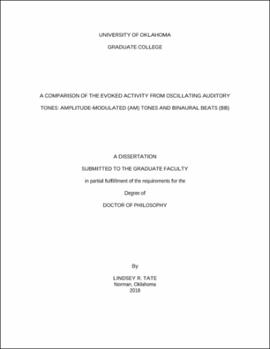| dc.contributor.advisor | Ethridge, Lauren | |
| dc.contributor.author | Tate, Lindsey | |
| dc.date.accessioned | 2018-11-20T16:14:13Z | |
| dc.date.available | 2018-11-20T16:14:13Z | |
| dc.date.issued | 2018-12 | |
| dc.identifier.uri | https://hdl.handle.net/11244/302099 | |
| dc.description.abstract | This study compares the neural response to binaural beat (BB) and amplitude-modulated tone (AM) auditory stimulation using power, phase-locking, and functional brain connectivity as assessed by electroencephalography (EEG). BB are produced when a different frequency sound is played in each ear, producing a pulsing or beat perception at the difference between the frequencies in each ear. The overarching goal of the study was to inform the understanding of the human auditory system and potential evidence-based therapies using binaural beats. BB 25 Hz and AM 25 Hz were processed very similarly, including: (1) a prominent phase-locking response at 50 Hz, (2) an increase in power at 50 Hz in the same bilateral auditory cortex electrodes, (3) the same right central cortical dipole identified for the maximum power in 50 Hz, (4) an unexpected decrease in power at 12 Hz, and (5) no differences in connectivity on the same scale as the 6 Hz stimuli differences. BB 6 Hz showed an auditory steady state response (ASSR) at 6 Hz and 12 Hz. AM 6 Hz drove higher increases in connectivity (relative to baseline) in some brain areas. BB 6 Hz drove connectivity increases in frontal, auditory, and occipital cortex-- areas that have been implicated in disorders with decreased connectivity. Because this study contains information about connectivity driven by BB, the findings from this study can inform future therapies for disorders where brain connectivity is decreased. Specific recommendations for therapies include using low-frequency binaural beats to induce increases in connectivity between any combination of frontal, auditory, and occipital areas. Because the 5-minute conditions did not show the same driving in frequency power that was shown for the 3-second conditions, our results suggest that repeated shorter bursts of stimulation are more effective than relatively long exposure times, which may be the result of habituation. | en_US |
| dc.language | en_US | en_US |
| dc.subject | binaural beats | en_US |
| dc.subject | EEG source analysis | en_US |
| dc.subject | EEG connectivity analysis | en_US |
| dc.subject | Dynamic Imaging of Coherent Sources (DICS) | en_US |
| dc.title | A COMPARISON OF THE EVOKED ACTIVITY FROM OSCILLATING AUDITORY TONES: AMPLITUDE-MODULATED (AM) TONES AND BINAURAL BEATS (BB) | en_US |
| dc.contributor.committeeMember | Carlson, Barbara | |
| dc.contributor.committeeMember | Gronlund, Scott | |
| dc.contributor.committeeMember | Berkowitz, Ari | |
| dc.contributor.committeeMember | Song, Hairong | |
| dc.date.manuscript | 2018-11-20 | |
| dc.thesis.degree | Ph.D. | en_US |
| ou.group | College of Arts and Sciences::Department of Psychology | en_US |
| shareok.nativefileaccess | restricted | en_US |
